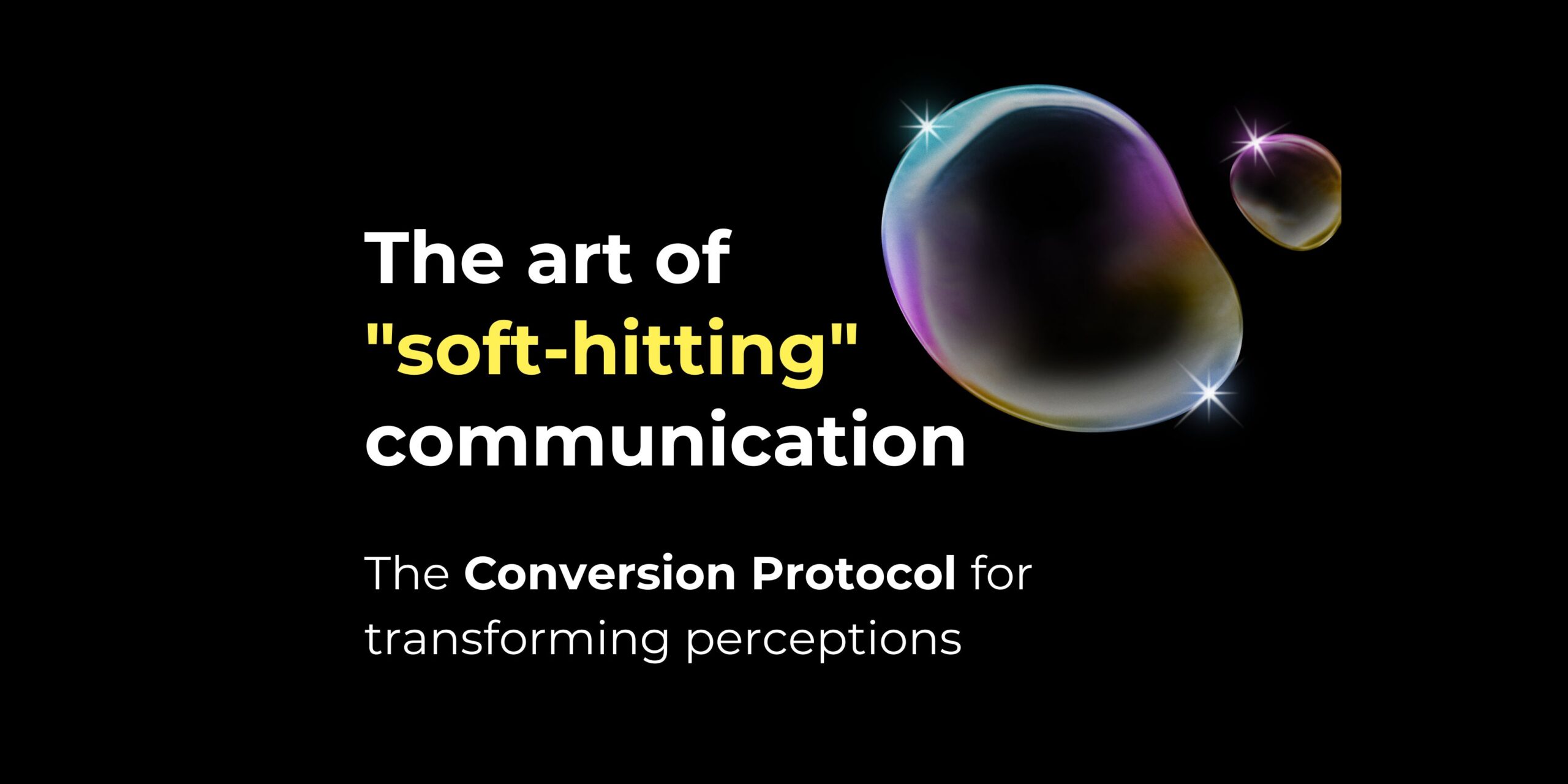Author: lb_admin
The Conversion Protocol | A proprietary technique – Linear B Group
The Conversion Protocol

If you have a product that’s marginally better or shinier than the rest, you’ll win.
The biggest challenge in business is selling something new.
No matter how much greater the benefits (or how logical your case) people just mistrust the unfamiliar.
Drawing on the latest psychological techniques, combined with our own communications expertise, we have developed the Conversion Protocol: a guide to changing the way people see the world.
Below, we showcase an overview of the approach. If you would like to know more, get in touch.
To build anything, you must take people on a journey.
You might want them to…
-
Switch service providers
From Acme Ltd to Ace LLP
-
Allocate to new asset classes
From liquid to committed
-
Adopt new processes
From manual to automated
-
Flip assumptions
From low fat to low sugar
Studies show the classic techniques of changing behaviours are rarely effective.

If you really want people to see things your way… read on
-

The right goals
Don’t try to ‘convince’ anyone. We like to change our own minds.
‘Soft-hitting‘ goals:
- Keep people listening
- Get them asking questions
-

Open a dialogue
Used too early, hard logic and facts can be counter-productive.
‘Soft-hitting‘ goals:
- Ask questions of them and listen to the answers
- Try to integrate their views into your narrative
-

Drop love bombs
Seeing things differently is mentally and emotionally costly. To do it, people must believe you are on their side.
- Find common ground
- Acknowledge their situation and challenges
-

Drop truth bombs
‘Weight of evidence’ tactics are intellectual ‘brute-force’. This repels most people.
- Truth bomb: a nugget of information that ‘speaks volumes’ and holds the seed of your idea
Drop, with precision
-

Show humility
The golden rule of PR is never admit to weakness. The golden rule of soft-hitting communications: ‘fess up early’.
Soft-hitting strategy:
- Volunteer the weaknesses in your position
- Earn trust, with disarming honesty
-

Be suggestive
The golden rule of PR is never admit to weakness. The golden rule of soft-hitting communications: ‘fess up early’.
Soft-hitting messages:
“You may start to notice the market shift in this direction”

Be repetitive
Sadly, most people will accept even obvious contradictions, if repeated often enough.
How much more powerful will be your simple truth, if you…
Repeat. Repeat. Repeat.
Profiles: what you really need to know
Classic account-based marketing begins by organising your audience by LinkedIn style personas – job title, sector, experience, etc.
But if you want to change people’s perspective, their most important characteristic is their receptivity to your message.
Therefore, segment your audience – not by job type or industry – but by their openness to change.
[octicons–arrow-down]
| Persona | Description | Features | Action |
|---|---|---|---|
| Immovables | Representative of the status quo. | Tied temperamentally or structurally to the status quo. Unreachable. | Accept their position and move on. |
| Sceptics | Active supporter of the status quo. | Resistant to change. Reachable. | Deploy full ‘Perceptions Protocol’. Converts become powerful advocates. |
| Novices | No strong view held. | Effected by general consensus. Not a change-leader. | Reached through ‘Repetition’ and social proof. |
| Receptives | Open to engagement. | Natural adopter, sometimes constrained by systems/bureaucracy. | Deploy logic and evidence sooner. |
| Advocates | An ally. | A convert, client or colleague. | Leverage their advocacy for social proof. |
Campaigns – how to apply the Conversion Protocol
Managing personas
Unlike the LinkedIn persona approach, you will need to assign personas dynamically, as your campaign and engagement with the market unfolds. The idea is to progress people down the chart.
- Organise your audience by persona, as far as possible.
- For unknowns, the default persona should be ‘Sceptics’.
- Capture ‘Novices’ with repetition.
- Funnel ‘Receptives’ quickly to ‘long-form’ insights.
- (Ignore ‘Immovables’.)
Content types, by persona
SCEPTICS
This audience should form the basis of any general communications campaign
Target with:
- Surveys (ask open questions)
- Green papers (ideas sharing, for debate)
- Seminars and forum Advertising (repetition)
NOVICES
This audience is most effected by repetition and social proof
Target with:
-
- Advertising
- Testimonials
- Regular social media postings
RECEPTIVES
Rich content for engaged prospects
Target with:
- White papers (authoritative)
- Long form articles Podcasts
- Direct email marketing.
Linear B Group is expert in helping companies with complex strategic communications challenges. Find out more.
The future ‘private markets’ customer
The holy grail of alternative asset management – tapping into the large and diverse investor base of wealthy individuals – is finally becoming a reality. The technical challenges, around structuring a scalable investment vehicle that can invest in less liquid assets without the restrictions and complexities of traditional funds, are being solved. But this is just the beginning.
The big challenge is how to connect with this vast and disparate pool of wealthy individuals in a way that maximises opportunity and minimises risks.
Answering these questions will help to lay the groundwork for your future outreach.
1. Is your culture and brand truly integrated?
This a market where even the largest alternatives brands are all-but unknown and the investment strategies unfamiliar. Successful prosecution of a mass-market strategy will result in high visibility for your brand. If it’s not truly reflective of your culture, you will be found out.
Everything you say and do from this moment onwards needs to be viewed in the context of this new market. This only happens with a commitment and clear intent from the executive leadership.
Consider conducting a thorough review of your values – as a brand and a business – in the context of this new customer base.
2. Does your brand ethos speak to the future customer?
This culture and values work will lay the ground for your brand ethos. Again, this is not necessarily an exercise in reinvention, but rather viewing what has gone before through a new prism – in this case from the institutional to the individual.
When a product moves from niche and artisan to mainstream and scalable, keeping control of the brand becomes increasingly complex, and building a firm foundation of values and ethos is an essential investment.
3. Understand how you are seen
A mass-marketing strategy devised by arm-chair experts will not survive one second in the wild unless it has been informed by real-world input. What does your target market already understand about your market, your competitors, your brand? How do they perceive such opportunities and what type of approaches are most likely to succeed? These questions must be answered for every region you intend to market within.
4. Refine your brand, messages and market positioning
Ideally, your messaging would be internationally coherent but regionally tailored, according to local perceptions, customs and regulation.
These outputs will be applied across a wide range of media and channels (almost of all of which will be very ‘short form’ while constrained by compliance) and so these brand assets must be available to internal stakeholders in a way that is both flexible but crystal clear as to their application.
5. Identify channels to market
At the same, you should map out your routes to market. The easiest method in this context – using investment intermediaries – is also the most expensive and least attractive in the long-term. By taking the time to develop direct proprietary marketing channels will mean you ‘own’ the relationship for the long-term.
Channels include media buying and advertising; paid social; media placement and earned outreach.
6. Develop a campaign strategy
Set realistic goals and timeframes. You won’t know what works until you try it, but breaking a new market takes time and therefore patience. How much are you going to commit to success and how long are you willing to tolerate failure?
A successful marketing campaign requires momentum, and this requires a plan.
Prioritise markets and customer sub-segments.
Consider starting small and testing your messaging in specific local markets.
Time your media channels: do you want to go ‘all in’, for example with TV advertising, newspaper and magazine advertising, billboards, social, earned coverage, and proactive PR; or stagger your channels to build momentum and increase your brand awareness over a certain time period?
7. Execute, learn, repeat
Executing an international quasi-retail campaign is an operationally complex undertaking. Setting up clear, regular reporting mechanisms and channels are essential to learning what is working and where to fine-tune messaging and re-allocate resources.
Get in touch
Communicating with a vulnerable customer-base
Companies and utilities can spend millions on marketing, but reputations tend to be lost or made at the margin. In the past, this may have been a slip of the CEO’s tongue, or a data breach, or an error of judgement. Today the biggest risk is around how you treat the marginal customer.
As we enter an unprecedented economic environment, with a cost-of-living crisis compounded by rapid inflation affecting the most vulnerable disproportionately, large consumer-facing businesses should be thinking hard about how they are communicating with all their customers, but most notably, those that could be described as vulnerable.
Here are some basic steps for how to approach this sensitive communications challenge.
- How do you actually treat vulnerable customers today?
When dealing with a vulnerable customer base, integrity cannot be over-emphasised. There is no room for cynicism or expediency. What you say and how you act must be integrated from the start.
It can be a good idea to begin by taking an honest review and audit of your values and culture with regards to the attitudes towards, and treatment of, vulnerable customers.
If it’s not exactly where you want it to be, then your first challenge is one of internal communications.
If done honestly, this process may run up against hard commercial realities. But we have found that when approached strategically, there tends to be fundamental alignment between the profit-motive and the good and fair treatment of customers.
- What language will you use?
For instance, in this article, we use the word ‘vulnerable’, but when dealing directly with customers, this may not be appropriate. It may well be the case that labelling or categorising customers in any way is to be avoided in external communications. But you will still need to define a clear lexicon and tone-of-voice to inform both marketing communications and front-line staff interactions.
- Make yourself highly approachable
You may have realised that what is good for your customers is good for you, but they may have some very understandable reasons to be cautious about revealing their vulnerability.
By making your position crystal clear and presenting your company as a good corporate citizen and constructive partner to all customers, you are much more likely to identify people who may be likely to run into difficulties, and direct them towards the support and solutions they need.
- Listen to frontline staff, focus groups, pressure groups
This is a fast-moving situation. The economic environment is deteriorating rapidly and how this plays out in people’s homes and lives should not be left to armchair predictions. Messaging must be informed but what people are actually saying and experiencing on the ground.
- Are you over-doing it?
For those in financial distress, the world can quickly become over-whelming. Make sure you aren’t contributing to this. For this customer segment, communication needs to be simple, clear and focused.
The worst case would be swamping them with inappropriate sales messages.
For regulated sectors such as financial services or energy, there will often be significant prescription around communications, but this is not a license to provide your vulnerable customers with a format that is anything other than simple, focused and clear.
- Informing your central market positioning
At the start, we referred to ‘marginal (or perhaps marginalised) customers’ – but financial vulnerability may become much more common than that.
How you treat people when it matters most, matters most. If you can develop a truly integrated response to vulnerability, whereby a strong communications toolkit is backed up by an operational reality, then not only will you have managed credit risk while supporting vulnerable people, but you will have a strong basis to develop a wider marketing message for all stakeholders – about how you treat people, and the type of company you aspire to be.
Get in touch
Analytical investment insights
Our Consulting team has built deep subject matter expertise in the area of private market investment, which allows us to provide high-value, highly technical marketing content to companies in this sector.
Attracting and sustaining the attention of a sophisticated institutional audience can be difficult and expensive but by partnering with Linear B, leading private market players can offer unique and tailored insights to their own teams and their client-based, in a cost-effective way.
In so doing, we create opportunities for our clients to have regular, high-value engagements with clients, investors or prospects.
Our research team provides a sophisticated view on specific private market segments, for instance, around fund investment opportunities. Outputs can include:
- Quarterly presentations of analysis;
- Introduction to the segment dynamics;
- A report on a target fund’s positioning and performance evaluation;
- Video-podcast with managing partner of target fund.
We also develop branded analytical communications, weaving in messaging that is tailored to your client base, so you can deliver value-added insights, efficiently and cost-effectively.
How we deliver
Our combined analytical and strategic marketing capabilities are unmatched in this market. Our private market experts and content-marketing professionals work seamlessly to create analytical communications in fully packaged, multi-media formats, for a sophisticated audience.
Analytical capabilities: our senior consultants develop insights and data-rich content. Themes our clients request include:
- Private market ‘hot topics’;
- Analyses of macro-trends and how they relate to specific investment trends;
- Data-driven insights into specific regions and strategies.
Marketing and creative: our editorial, digital, design and recording studio presents the content across multiple channels, repurposed for maximum impact.
Frequencies: we provide monthly, quarterly and bi-annual communications, as well as annual or ad hoc studies and reports.
Outputs and channels
We deliver across a variety of interactive, leading-edge marketing channels. (The frequency, depth and tone are jointly defined with clients to meet their specific objectives.)
- Outlook briefings – digital products
Branded online publications / interactive micro-sites, with insight and analysis, sponsored or customised to deliver specific strategic messages.
- Interactive presentation & webinar
Our consultants lead presentations and/or moderate guest webinars to introduce the latest edition and provide a forum for engagement and interaction with your stakeholders.
- Traditional & physical content
A well-presented physical document ‘stands out from the crowd’ as a way to present branded insights and analysis.
- Website-based insights
We provide summary versions for public website, with full access and library behind log-in.
- Email and social campaign
We develop email campaigns and social media outreach, to build-out email lists.
The outputs can be for in-house use only; fully white labelled as your own; presented as semi-independent editorialised content; or as exclusive sponsored content.
Key benefits
- Sophisticated analysis and insight on prospects
- Client engagement: Provide engagement opportunities with your clients and prospects.
- Positioning: Strategic positioning on thematic topics.
- Customer insight: Go-to source of insight for your clients.
- Efficiency and cost: Minimal internal burden for maximum value.
If you would like more information, please get in touch.





